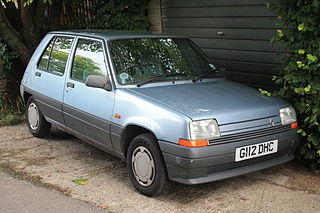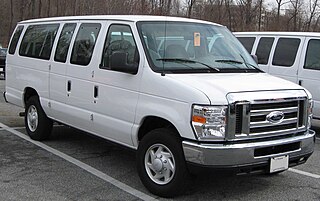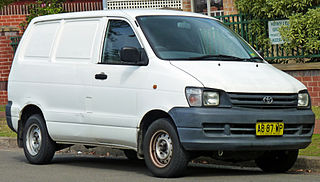
The Ford Anglia is a small family car that was designed and manufactured by Ford UK. It is related to the Ford Prefect and the later Ford Popular. The Anglia name was applied to various models between 1939 and 1967. In total, 1,594,486 Anglias were produced. It was replaced by the Ford Escort.

The Ford Sierra is a mid-size car or large family car manufactured and marketed by Ford Europe from 1982–1993, designed by Uwe Bahnsen, Robert Lutz and Patrick le Quément — and noted for its aerodynamic styling producing a drag coefficient of 0.34, a significant improvement over its predecessors.

The Volvo 140 Series is a line of mid-size cars manufactured and marketed by Volvo from 1966 to 1974 in two- and four-door sedan as well as five door station wagon body styles—with numerous intermediate facelifts. More than a million Volvo 140s were built.

The Renault Clio is a supermini (B-segment) car, produced by French automobile manufacturer Renault. It was launched in 1990, and entered its fifth generation in 2019. The Clio has had substantial critical and commercial success, being consistently one of Europe's top-selling cars since its launch, and it is largely credited with restoring Renault's reputation and stature after a difficult second half of the 1980s. The Clio is one of only two cars, the other being the Volkswagen Golf, to have been voted European Car of the Year twice, in 1991 and 2006.

The Renault Mégane, also spelled without the acute accent as Megane, especially in languages other than French, and also known as the Renault Megavan for an LCV in Ireland, as the Renault Scala in Iran and as the Renault Mégane Grandcoupé for the saloon in Israel, Palestinian Authority and Serbia for certain generations, is a small family car produced by the French car manufacturer Renault for the 1996 model year, and was the successor to the Renault 19. The Mégane has been offered in three- and five-door hatchback, saloon, coupé, convertible and estate bodystyles at various points in its lifetime, and having been through four generations is now in its fifth incarnation.

The Renault Trafic is a light commercial van produced by the French automaker Renault since 1980. It has also been marketed as the Fiat Talento, the Nissan NV300, the Nissan Primastar and the Mitsubishi Express. Until 2018, it was also sold as the Opel/Vauxhall Vivaro by Opel and its associated company Vauxhall. From early 2022 onwards, the van is also marketed by Renault Trucks as the Renault Trucks Trafic.

The Renault 5 is a five-passenger, three or five-door, front-engine, front-wheel drive hatchback supermini manufactured and marketed by the French automaker Renault over two generations: 1972–1985 and 1984–1996.

The Renault Espace is a series of automobiles manufactured by Renault since 1984. For its first five generations, the Espace was a multi-purpose vehicle/MPV (M-segment), but it has been redesigned as a mid-size crossover SUV for its sixth generation.

The Renault Kangoo is a family of vans built by Renault since 1997 across three generations. It is sold as a passenger multi-purpose vehicle or as a light commercial vehicle. For the European market, the Kangoo is manufactured at the MCA plant in Maubeuge, France.

The Renault 4, or R4 in short, is an economy car built by the French company Renault from 1961 to 1994. Although the Renault 4 was first marketed as a short estate or wagon, its minimal rear overhang, and its top-hinged, single-piece tail-gate made it the world's first mass-produced hatchback car, as well as the first time Renault had used a front-wheel-drive layout in a family car. A bare-bones, entry-level Renault 3, or R3 was also offered in 1961/1962.

The Renault Scénic, also spelled without the acute accent as Scenic, especially in languages other than French, is a car which was produced by French car manufacturer Renault, the first to be labelled as a small multi-purpose vehicle (MPV) in Europe. The first generation was based on the chassis of the Mégane, a small family car. It became the 1997 European Car of the Year on its launch in November 1996. In May 2022 Renault announced it was discontinuing the standard Scénic with the Grand Scénic following shortly after. It will be relaunched in 2024 as a fully electric vehicle called the Renault Scénic E-Tech which will be the production version of the Renault Scénic Vision concept unveiled in 2022, with the production version to be unveiled at the 2023 Munich Motor Show on September 4.

The Ford E-Series is a range of full-size vans manufactured and marketed by the Ford Motor Company. Introduced for 1961 as the replacement of the Ford F-Series panel van, four generations of the model line have been produced. Marketed for both cargo and passenger transport configurations, the E-Series has been designed with multiple design variations for both retail and commercial sale, including vans, and commercial-grade cutaway van chassis and stripped chassis.

Ford Courier is a model nameplate used by Ford since the early 1950s. The Courier moniker has been used on a variety of vehicles all around the world since it was first used in North America for a sedan delivery. The Courier nameplate was also used by Ford for a series of compact pickup trucks and would also see use by Ford of Europe denoting a Fiesta-based panel van. Ford Brazil used the nameplate for a Fiesta-based coupe utility pickup marketed across Latin America.

The Dodge Ram Van is a range of full-size vans that were produced by Chrysler Corporation from the 1971 to 2003 model years. Replacing the Dodge A100, the Ram Van transitioned to a front-engine drivetrain configuration. Mostly offered as a cargo van and a passenger van, the model line was also initially offered as a cutaway van chassis.

The Renault Master is a large van produced by the French manufacturer Renault since 1980, now in its third generation. It replaced the earlier Renault Super Goélette light trucks. Opel has sold versions of the second and third series vans as the Opel Movano in Continental Europe and Vauxhall Movano in the United Kingdom. All three generations have been designed and manufactured by Renault, irrespective of the brand. Renault Trucks markets it as the Renault Trucks Master.

The Gloria is a large luxury car made from 1959 by the Prince Motor Company, and later by Nissan Motors since its merger with the former - hence being originally marketed as Prince Gloria and later as Nissan Gloria. Initially based on the smaller Prince Skyline, the Gloria line was merged with Nissan Cedric starting with 1971 models and both continued until 2004, when they were both replaced by Nissan Fuga.

The Fiat Fiorino is a small commercial vehicle produced by the Italian car manufacturer Fiat since 1977. Its first two generations have been the panel van derivatives of other small models, such as the Fiat 127 and Fiat Uno, while the current third generation was developed jointly with PSA Peugeot Citroën, and is based on the Fiat Small platform.

The Toyota LiteAce and TownAce are a line of light commercial and derivative passenger vans produced by the Japanese car manufacturer Toyota. These vehicles originally utilized the cab-over-engine configuration, although since 1996 a semi-cab-over arrangement has featured instead. The LiteAce launched in 1970 as light-duty truck, with commercial and van/wagon body variants added in 1971. In 1976, Toyota released the larger TownAce van/wagon that derived from the LiteAce; a TownAce truck arrived later in 1978. Between 1982 and 1992, the series accommodated the MasterAce Surf—an upscale TownAce passenger wagon.

The Iveco Daily is a large light commercial van produced by the Italian automaker Iveco since 1978; it was also sold as the Fiat Daily by Fiat until 1983. Unlike the more car-like unibody Fiat Ducato, the Daily uses a separate ladder frame typical of heavier commercial vehicles. The Iveco Daily is produced at the Iveco Suzzara plant, near Mantova in Italy, where Iveco has recently made substantial investments to renew the production lines.

The Chevrolet Van or Chevy Van is a range of vans that was manufactured by General Motors from the 1964 to 1996 model years. Introduced as the successor for the rear-engine Corvair Corvan/Greenbrier, the model line also replaced the panel van configuration of the Chevrolet Suburban. The vehicle was sold both in passenger van and cargo van configurations as well as a cutaway van chassis that served as the basis for a variety of custom applications.



























